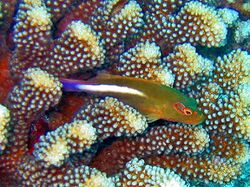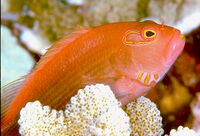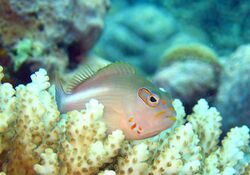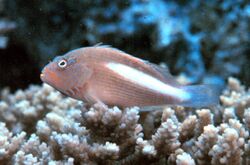Biology:Arc-eye hawkfish
| Arc-eye hawkfish | |
|---|---|

| |
| Paracirrhites arcatus in Polynesia | |
Not evaluated (IUCN 3.1)
| |
| Scientific classification | |
| Kingdom: | |
| Phylum: | |
| Class: | |
| Order: | |
| Family: | |
| Genus: | |
| Species: | P. arcatus
|
| Binomial name | |
| Paracirrhites arcatus (G. Cuvier, 1829)
| |
| Synonyms | |
| |
The arc-eye hawkfish (Paracirrhites arcatus) is a species of hawkfish belonging to the genus Paracirrhites. It is found in shallow waters in the tropical IndoPacific on reefs, resting on coral heads much of the time.
Etymology
The genus name Paracirrhites derives from the Greek word para, meaning "the side of" plus the Latin word cirrus, meaning "curl". The species name arcatus, meaning "arched", refers to the U-shaped marking around the eyes.
Description
Paracirrhites arcatus grows to a maximum size of 20 cm in length, and occurs in a variety of colors. The body may be greenish-brown, dark brown or reddish-orange, while the tail usually is bluish. A broad, longitudinal white band runs along the distal half of the body. A characteristic ring-shaped or U-shaped tricolor marking (red, blue and yellow) occurs around and behind the eyes. The dorsal fin has ten spines and eleven soft rays, and the anal fin has three spines and six soft rays. These voracious predators are very territorial. They spend most of their time perched on corals, especially Acropora, Stylophora, and Pocillopora genera, waiting for prey to approach too close. They mostly feed on small fishes, shrimps, and crabs but also eat isopods, fish eggs and larvae.[1] These fish occasionally find their way into the aquarium trade.
Distribution
The arc-eye hawkfish is widespread in the tropical Indo-Pacific. Its range extends from East Africa, Madagascar and the Maldives to Hawaii, southern Japan and western, northern and eastern Australia.[1]
Habitat
The arc-eye hawkfish is a benthic species associated with coral reefs. It usually can be found in lagoon and seaward reefs, at a depth of 1–30 m (3 ft 3 in–98 ft 5 in), with a maximum of 91 m (299 ft).
References
- ↑ 1.0 1.1 "Paracirrhites arcatus (Cuvier, 1829): Arc-eye hawkfish". FishBase. http://www.fishbase.us/summary/Paracirrhites-arcatus.html. Retrieved 2013-12-27.
- The Fishes of the Indo-australian Archipelago. Brill Archive. pp. 8–. GGKEY:05ZET4L61B1. https://books.google.com/books?id=qKg3AAAAIAAJ&pg=PA8.
- Anonym, 2000. Data base of J.L.B. Smith Institute of Ichthyology, Grahamstown, South Africa. J.L.B. Smith Institute of Ichthyology, Grahamstown, South Africa .
- Anonym, 2001. Data base of National Museum of Natural History (Smithsonian Institution). Smithsonian Institution - Division of Fishes.
- Anonym, 2002. Data base of American Museum of Natural History. American Museum of Natural History, Central Park West, NY 10024-5192, United States.
- Gibbons, S., 1999. Collect fish on stamps. Stanley Gibbons Ltd., London i Ringwood. 418 p.
- Munz, F.W. i W.N. McFarland, 1973. The significance of spectral position in the rhodopsins of tropical marine fishes. Vision Res.13:1829-1874.
- Randall, J.E., 1986. Cirrhitidae. P. 664-666. A: M.M. Smith i P.C. Heemstra (eds.). Smiths' sea fishes. Springer-Verlag, Berlín.
- Robins, C.R., R.M. Bailey, C.E. Bond, J.R. Brooker, E.A. Lachner, R.N. Lea i W.B. Scott, 1991. World fishes important to North Americans. Exclusive of species from the continental waters of the United States and Canada. Am. Fish. Soc. Spec. Publ. (21):243 p.
- Wheeler, A., 1977. Das grosse Buch der Fische. Eugen Ulmer GmbH & Co. Stuttgart. 356 p.
- Wu, H.L., K.-T. Shao i C.F. Lai (eds.), 1999. Latin-Chinese dictionary of fishes names. The Sueichan Press, Taiwan.
External links
- BioLib
- Barcodes of Life
- NCBI
- AQUATAB
- Animal Diversity Web
- Encyclopedia of Life
- World Register of Marine Species
- ITIS
- UNEP-WCMC Species Database
Wikidata ☰ Q1043574 entry




